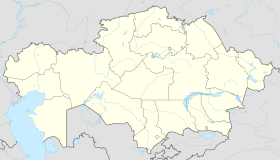Balkhash (city)
|
Balkhash Балқаш |
|
|---|---|
| City | |

Centre of the city
|
|
| Location in Kazakhstan | |
| Coordinates: 46°50′53″N 74°59′42″E / 46.84806°N 74.99500°ECoordinates: 46°50′53″N 74°59′42″E / 46.84806°N 74.99500°E | |
| Country | Kazakhstan |
| Region | Karaganda Region |
| Founded | 1931 |
| Incorporated (city) | 1937 |
| Government | |
| • Akim (mayor) | Nurlan Erikbaevich Aubakirov (since 29 May 2012) |
| Elevation | 440 m (1,440 ft) |
| Population (2009) | |
| • City | 68,833 |
| • Urban | 77,662 |
| Postal code | 100300 - 100316 |
| Area code(s) | +7 71036 |
| Website | www |
Balkhash (Kazakh: Балқаш, Balqaş; Russian: Балхаш, Balkhash) is a city in Kazakhstan, located on the northern shore of the Lake Balkhash, on the Bay Bertys, and in south of Kazakh Uplands. Population of the city: 68,833 (2009 Census results); 65,431 (1999 Census results).
Balkhash was founded in 1937 as an industrial city centred on the mining and smelting of copper, and presently copper is still exploited there. The city lies approximately 500 km west of the Chinese border on the north side of the lake at an altitude of 440 m.
The history of the city is closely connected with mining of deposits of copper and development of a smelting plant.
On 11 April 1937, a small worker`s settlement "Pribalhashstroy", designed in connection with the construction of a copper factory - BGMC, was transformed into the city of Balkhash by decision of the Central Executive Committee of the Kazakh SSR. In this way, the copper factory effected the city's appearance.
On 9 November 1932, the first school was established in the city - school № 1. The school educated a few children of the builders of the city that time. Among these children was Maria Nicolaevna Guseva (Halova). This school became a matter of her life: firstly she was one of the first pupils. Later, she became a teacher. In 1935, a section for parachuting was opened. Its first director was Dyusembayev.
During the Great Patriotic War (Russian term for World War II), most of the male population was conscripted into the military service and women replaced them in the copper factory.
After World War II, Japanese war prisoners took part in the building of the city. In particular, they built buildings, the "Palace of Metallurgists" and the local airport.
After the collapse of the Soviet Union, between 1992 and 1996, the city and its residents, like most former Soviet citizens, experienced an acute crisis, including power outages, weak central heating and intermittent operation of the copper factory. Some people cooked on fires in their yards; in winter they heated their apartments with potbelly stoves. Summer cottages served as an additional source of foodstuffs, contributing to the populace's survival. In the late 1990s, the city's and country's economies stabilised. A new neighborhood was built in the city, the so-called "Canadian cottages". All schools, medical facilities and the college started to function normally.
...
Wikipedia

